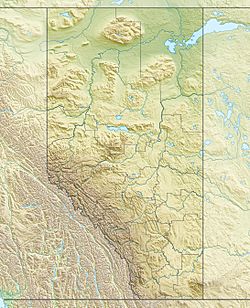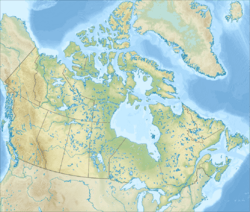Carseland facts for kids
Quick facts for kids
Carseland
|
|
|---|---|
| Country | Canada |
| Province | Alberta |
| Region | Southern Alberta |
| Census division | 5 |
| Municipal district | Wheatland County, Alberta |
| Government | |
| • Type | Unincorporated |
| Area
(2021)
|
|
| • Land | 0.56 km2 (0.22 sq mi) |
| Population
(2021)
|
|
| • Total | 542 |
| • Density | 963.2/km2 (2,495/sq mi) |
| Time zone | UTC−07:00 (MST) |
| • Summer (DST) | UTC−06:00 (MDT) |
| Area code(s) | 403, 587, 825 |
Carseland is a small community called a hamlet in Alberta, Canada. It's part of Wheatland County. You can find it on Highway 24. It is about 23 kilometers (14 miles) south of Cheadle. It is also about 26 kilometers (16 miles) south of Strathmore. Carseland is located within Census Division No. 5.
Contents
History of Carseland
Early Settlers and Ranching
In the late 1800s, cattle ranchers came to the Bow River area. This was west of the Blackfoot Indian Reserve. Important people like Major General Thomas Bland Strange arrived in 1881. Others included Charlie Hawks and Colonel Arthur Goldfinch. Felix McHugh and Colonel Arthur Wyndham also came to the Carseland area.
Major General Strange started a company called the Military Colonization Company. When it closed, the Canadian Pacific Railway (CPR) allowed free grazing. This was on their 3 million acres north of the Bow River. Many new settlers were attracted to the area.
In 1901, the Addemans, Moffats, and McGregors bought a ranch called the Horsetrack. They started the Horsetrack Cattle Company. Other families like Groves, Moorhouse, and Brown soon followed. When the time of open range ranching ended, many cattlemen became the first grain farmers.
Farming and Railway Growth
In 1903, the CPR brought irrigation to its large land in Carseland. This helped the land become very productive. More farm products were then shipped by train to markets.
Because of this, the CPR began building a new railway line in 1913. This line was called the Gleichen/Shepard cut-off. These railway tracks were even used to carry troops in 1914. This was during the First World War.
Carseland's Busy Years
Carseland grew quickly between the 1920s and 1940s. Its location near the river and railway helped it become a busy community. It had many businesses and services. There were six grain elevators and a railway station. The town also had a school and a general store.
Other businesses included a barber shop and a pool-room. There was a post office, a restaurant, and a garage. A Ford car dealer was also in town. Carseland had a lumber yard, a hardware store, and a meat market. It also had a bank, stock yards, two churches, a hotel, and a community center.
Today, only three original buildings from 1916 remain on Railway Avenue. These are the hotel and the former hardware store. The old meat market, owned by the Bonitz family, is now the post office in a strip mall.
Population of Carseland
In 2021, Carseland had a population of 542 people. These people lived in 218 homes. This was a small increase from its 2016 population of 525 people. Carseland covers a land area of about 0.56 square kilometers (0.22 square miles).
Economy
Carseland has several important employers. The main companies that provide jobs in Carseland are Nutrien, Orica, and Stella-Jones.



